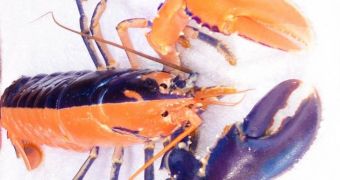A rare two-tone lobster has become even more stunning after shedding its skin to expose a unique and spectacular combination of colors.
After being found off Bridlington, East Yorkshire in June 2010, the unusual crustacean was deemed too spectacular to be served up on a plate in the form of a fancy meal. So, it was handed over to the Scarborough Sea Life Centre, where it currently lives and delights visitors.
The two-tone lobster was named Harley Quinn, after the medieval clown famous for his bi-colored costume.
The unusual creature, which is believed to be five or six years old, has just molted its shell for the second time since its arrival at the aquarium as a result of its growing up, and revealed an intense electric blue on one side and its usual orange on the other.
Keepers have been fascinated by the strangely colored lobster since it arrived at the center and closely monitored the changes in its special pigmentation. They now say that its new suit is the most eye-catching yet. What’s even more impressive about Harley is that the strange pigmentation interchanges when it reaches its claws.
“Whereas he was previously a reddish-black on one side and light sandy color on the other, he has now adopted a deep electric blue down one side,” aquarist Amy McFarlane said, according to Daily Mail.
As it turns out, unusual blue, red, albino, and even yellow lobsters have been seen in the past, including at Scarborough Sea Life Centre, but Harley is considered the most spectacular yet.
Experts were amazed when they first saw the crustacean, saying that the chances of a lobster having a different color on each side of its body are around 1 in 50 million. They explain that the lobster is divided into two different colors by a perfect straight line down its carapace due to a genetic mutation.
Researchers from the University of Connecticut discovered that the presence of too much protein in a lobster’s body causes its coat to adopt a blue hue. Apparently, the protein combines with a red carotenoid molecule to create the beautiful bright color.
Moreover, the color of most lobsters intensifies with each molt.
“The process is much the same with normal lobsters but I’ve never seen one that's half and half with a weird transfer of color on its claws – he looks like an old fashioned harlequin jester,” a representative for the center said.

 14 DAY TRIAL //
14 DAY TRIAL //